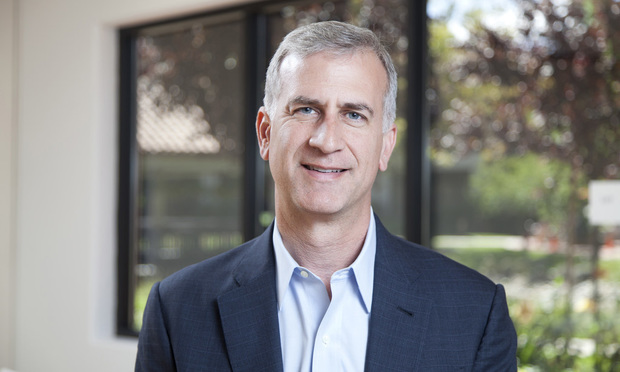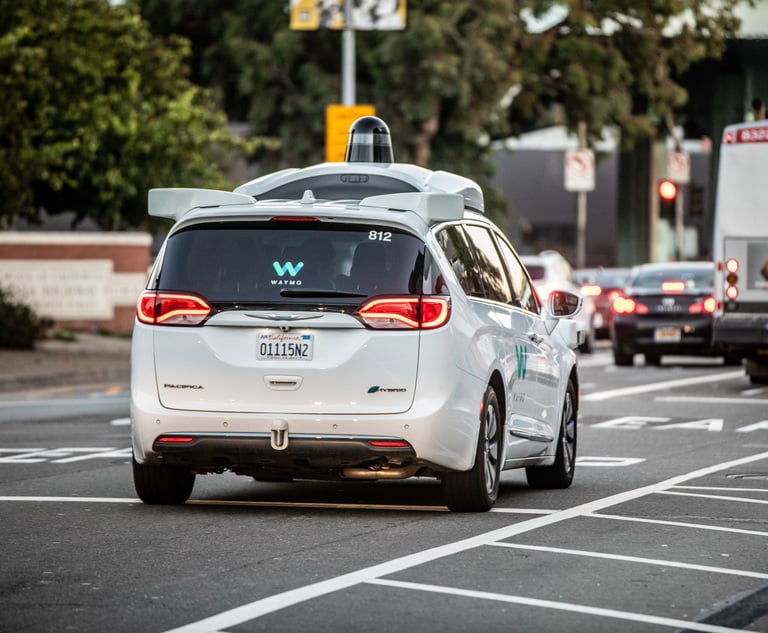Lidar Supplier for Self-Driving Vehicles Is Sensing Patent Infringement
San Jose-based Velodyne LiDAR and Latham & Watkins are accusing two Chinese companies of copying its sensors that help autonomous vehicles navigate the road.
August 15, 2019 at 12:36 PM
3 minute read
 Douglas Lumish, Latham & Watkins. (Photo: Jason Doiy/ALM)
Douglas Lumish, Latham & Watkins. (Photo: Jason Doiy/ALM)
A Silicon Valley manufacturer of lidar systems for autonomous driving is asserting a newly battle-tested patent against two Chinese competitors.
San Jose-based Velodyne LiDAR Inc. is accusing Hesai Photonics Technology Co. Ltd. and Suteng Innovation Technology Co. Ltd. of infringing its patented rotating devices that can be mounted on the roofs of self-driving vehicles.
Velodyne and its Latham & Watkins attorneys say the company pioneered the system of rotating laser emitters and avalanche photodiode detectors that create a 360-degree field of view of sensors. Velodyne founder David Hall patented the technology in 2011.
“Hesai took Velodyne’s revolutionary invention and incorporated it into its own competing products,” states Velodyne’s complaint against Hesai, which is signed by Latham partner Douglas Lumish. “Even worse, Hesai knew of and studied Velodyne’s products and patented technology before incorporating it into Hesai’s infringing products.”
Hesai, which is based in Shanghai, and Suteng, which is based in Shenzhen and is also known as RoboSense, did not immediately respond to emailed requests for comment.
Velodyne’s complaints claim that the company and Hall “changed the course of history by making autonomous vehicles a reality,” beginning with DARPA’s 2007 Urban Challenge for autonomous driving. The company provided lidar systems, which stands for light detection and ranging, for Google for a number of years, and more recently received a $150 million investment from Ford Motor Co. and Baidu.
The technology is also used in driver assistance systems and has applications in aerial mapping, robotics and industrial safety. Velodyne announced in March that it has shipped 30,000 lidar sensors worth about $500 million to some 250 customers. It is rumored to be looking to go public by the end of 2019.
Sunnyvale competitor Quanergy Systems Inc. challenged the validity of the same 7,969,558 patent last year before the Patent Trial and Appeal Board. After the PTAB initiated proceedings Velodyne offered to narrow its claims. But the PTAB ultimately ruled that wasn’t necessary, finding that the commercial success and industry praise for Velodyne’s lidar showed that its invention was “revelatory and not obvious.”
“As the PTAB found, Mr. Hall’s claimed invention, as embodied in Velodyne’s HDL-64E sensor, resolved a long-felt need for a LiDAR sensor that could capture distance points rapidly in all directions and produce a sufficiently dense 3-D point cloud for use in autonomous navigation,’” Lumish writes in Tuesday’s complaints.
Velodyne accuses each of its two competitors of willfully infringing. “Robosense knew of and studied Velodyne’s products and patented technology before it incorporated that technology into its own products, as its personnel admitted in public interviews,” Lumish writes in the complaint against RoboSense.
Also on the complaint are Latham partners Jeffrey Homrig, Patricia Young and Ann Marie Wahls. Latham counsel Jonathan Strang and associate Brett Sandford represented Velodyne at the PTAB.
This content has been archived. It is available through our partners, LexisNexis® and Bloomberg Law.
To view this content, please continue to their sites.
Not a Lexis Subscriber?
Subscribe Now
Not a Bloomberg Law Subscriber?
Subscribe Now
NOT FOR REPRINT
© 2025 ALM Global, LLC, All Rights Reserved. Request academic re-use from www.copyright.com. All other uses, submit a request to [email protected]. For more information visit Asset & Logo Licensing.
You Might Like
View All
Shareholder Democracy? The Chatter Musk’s Tesla Pay Case Is Spurring Between Lawyers and Clients
6 minute read
Willkie Farr & Gallagher Drives Legal Challenge for Uber Against State's Rideshare Laws
5 minute read

EPA grants California authority to ban sales of new gas cars by 2035. Action faces reversal by Trump
Trending Stories
- 1South Florida Attorney Charged With Aggravated Battery After Incident in Prime Rib Line
- 2'A Death Sentence for TikTok'?: Litigators and Experts Weigh Impact of Potential Ban on Creators and Data Privacy
- 3Bribery Case Against Former Lt. Gov. Brian Benjamin Is Dropped
- 4‘Extremely Disturbing’: AI Firms Face Class Action by ‘Taskers’ Exposed to Traumatic Content
- 5State Appeals Court Revives BraunHagey Lawsuit Alleging $4.2M Unlawful Wire to China
Who Got The Work
J. Brugh Lower of Gibbons has entered an appearance for industrial equipment supplier Devco Corporation in a pending trademark infringement lawsuit. The suit, accusing the defendant of selling knock-off Graco products, was filed Dec. 18 in New Jersey District Court by Rivkin Radler on behalf of Graco Inc. and Graco Minnesota. The case, assigned to U.S. District Judge Zahid N. Quraishi, is 3:24-cv-11294, Graco Inc. et al v. Devco Corporation.
Who Got The Work
Rebecca Maller-Stein and Kent A. Yalowitz of Arnold & Porter Kaye Scholer have entered their appearances for Hanaco Venture Capital and its executives, Lior Prosor and David Frankel, in a pending securities lawsuit. The action, filed on Dec. 24 in New York Southern District Court by Zell, Aron & Co. on behalf of Goldeneye Advisors, accuses the defendants of negligently and fraudulently managing the plaintiff's $1 million investment. The case, assigned to U.S. District Judge Vernon S. Broderick, is 1:24-cv-09918, Goldeneye Advisors, LLC v. Hanaco Venture Capital, Ltd. et al.
Who Got The Work
Attorneys from A&O Shearman has stepped in as defense counsel for Toronto-Dominion Bank and other defendants in a pending securities class action. The suit, filed Dec. 11 in New York Southern District Court by Bleichmar Fonti & Auld, accuses the defendants of concealing the bank's 'pervasive' deficiencies in regards to its compliance with the Bank Secrecy Act and the quality of its anti-money laundering controls. The case, assigned to U.S. District Judge Arun Subramanian, is 1:24-cv-09445, Gonzalez v. The Toronto-Dominion Bank et al.
Who Got The Work
Crown Castle International, a Pennsylvania company providing shared communications infrastructure, has turned to Luke D. Wolf of Gordon Rees Scully Mansukhani to fend off a pending breach-of-contract lawsuit. The court action, filed Nov. 25 in Michigan Eastern District Court by Hooper Hathaway PC on behalf of The Town Residences LLC, accuses Crown Castle of failing to transfer approximately $30,000 in utility payments from T-Mobile in breach of a roof-top lease and assignment agreement. The case, assigned to U.S. District Judge Susan K. Declercq, is 2:24-cv-13131, The Town Residences LLC v. T-Mobile US, Inc. et al.
Who Got The Work
Wilfred P. Coronato and Daniel M. Schwartz of McCarter & English have stepped in as defense counsel to Electrolux Home Products Inc. in a pending product liability lawsuit. The court action, filed Nov. 26 in New York Eastern District Court by Poulos Lopiccolo PC and Nagel Rice LLP on behalf of David Stern, alleges that the defendant's refrigerators’ drawers and shelving repeatedly break and fall apart within months after purchase. The case, assigned to U.S. District Judge Joan M. Azrack, is 2:24-cv-08204, Stern v. Electrolux Home Products, Inc.
Featured Firms
Law Offices of Gary Martin Hays & Associates, P.C.
(470) 294-1674
Law Offices of Mark E. Salomone
(857) 444-6468
Smith & Hassler
(713) 739-1250






